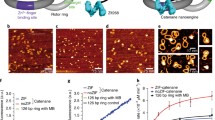Abstract
In this paper, we propose an autonomous molecular walking machine using DNA. This molecular machine follows a track of DNA equipped with many single-strand DNA stators arranged in a certain pattern. The molecular machine achieves autonomous walk by using a restriction enzyme as source of power. With a proposed machine we can control its moving direction and we can easily extend walking patterns in two or three dimensions. Combination of multiple legs and ssDNA stators can control the walking pattern. We designed and performed a series of feasibility study with computer simulation and molecular biology experiments.








Similar content being viewed by others
Explore related subjects
Discover the latest articles, news and stories from top researchers in related subjects.References
Bath J, Green SJ, Turberfield AJ (2005) A free-running DNA motor powered by a nicking enzyme. Angew Chem Int Ed 44:4358–4361
Benenson Y, Paz-Elizur T, Adar R, Keinan E, Livneh Z, Shapiro E (2001) Programmable and autonomous computing machine made of biomolecules. Nature 414:430–434
Lucia JS Jr, Hicks D (2004) The thermodynamics of DNA structural motifs. Annu Rev Biophys Biomol Struct 33:415–440
Pei R, Taylor SK, Stefanovic D, Rudchenko S, Mitchell TE, Stojanovic MN (2006) Behavior of polycatalytic assemblies in a substrate-displaying matrix. J Am Chem Soc 128:12693–12699
Sherman WB, Seeman NC (2004) A precisely controlled DNA biped walking device. Nano Lett 4:1203–1207
Shin J-S, Pierce NA (2004) A synthetic DNA walker for molecular transport. J Am Chem Soc 126:10834–10835
Taylor JW, Schmidt W, Cosstick R, Okruszek A, Eckstein F (1985) The use of phosphorothioate-modified DNA in restriction enzyme reactions to prepare nicked DNA. Nucleic Acids Res 13:8749–8764
Tian Y, He Y, Chen Y, Yin P, Mao C (2005) A DNAzyme that walks processively and autonomously along a one-dimensional track. Angew Chem Int Ed 44:4355–4358
Utagawa E, Sekine M, Seio K (2006) cis-Tetrahydrofuran-3,4-diol structure as a key skeleton of new protecting groups removable by self-cyclization under oxidative conditions. J Org Chem 71:7668–7677
Verma S, Eckstein F (1998) Modified oligonucleotides: synthesis and strategy for users. Annu Rev Biochem 67:99–134
Winfree E, Liu F, Wenzler LA, Seeman NC (1998) Design and self-assembly of two-dimensional DNA crystals. Nature 394:539–544
Yin P, Yan H, Daniell XG, Turberfield AJ, Reif JH (2004) A unidirectional DNA walker that moves autonomously along a track. Angew Chem Int Ed 43:4906–4911
Yoshimura Y, Okamura D, Ogino M, Fujimoto K (2006) Highly selective and sensitive template-directed photoligation of DNA via 5-carbamoylvinyl-2-deoxyuridine. Org Lett 8(22):5049–5052
Zheng J, Constantinou PE, Micheel C, Alivisators AP, Kiehl RA, Seeman NC (2006) Two dimensional nanoparticle arrays show the organizational power of robust DNA motifs. Nano Lett 6:1502–1504
Author information
Authors and Affiliations
Corresponding author
Appendix: Fok I as a nicking enzyme
Appendix: Fok I as a nicking enzyme
We examined to achieve a function which is the same as a nicking enzyme by using Fok I and phosphorothioate-modified DNA. Fok I cleaves both of double-strand, this cleaving activity is not suitable for the molecular walking machine. We expected to block the cleaving activity at the cut point of one strand by phosphorothioate-modified DNA (Fig. 9). Remark that for our walking machine, only legs need phosphorothioate modification.
We experimented to confirm the effect of phosphorothioate-modified DNA. We prepared five DNA strands for the experiment (Table 3). The five DNA strands compose the following four sets:
-
(1)
unmodified and separated the recognition site and the cut point;
-
(2)
phosphorothioate-modified and separated the recognition site and the cut point;
-
(3)
unmodified and unseparated;
-
(4)
phosphorothioate-modified and unseparated.
Each four sets of DNA strands were mixed at 0.3 μM in hybridization buffer. NEBuffer4 from New England Biolabs was used as the hybridization buffer. 4 units of Fok I from New England Biolabs were added to each five sets 20 μl solution. The four sets were incubated at 37°C by 2 h.
We ran the resulting solutions in 16% PAGE (non-denaturing gel).
For this result, we found phosphorothioate-modified DNA could block the cleaving activity a little (Fig. 10). There were phosphorothioate-modified DNA with separate point in lane 4, and no-modified DNA with separate point in lane 2. To compare the two lanes, we confirmed that phosphorothioate-modified DNA was cleaved. The length 24mer band is the products of cleaving F-33 at the cut point, and there is the same band in lane 4. So this result shows phosphorothioate-modified DNA was cleaved.
Result of experiment of phosphorothioate-modified. 1, 2—unmodified and separated (F-13, F-20, F-33); 3, 4—phosphorothioate-modified and separated (F-13, F-20, F-33s); 5, 6—unmodified and not separated (F-13 + 20, F-33); 7, 8—phosphorothioate-modified and not separated (F-13 + 20, F-33s). Odd number of lane: without Fok I, Even number of lane: with Fok I
In this regard, however there is the length 33mer band in lane 4. The band shows a few F-33s remained not to be cleaved. And there is the band which shows unreacted DNA strand. This band isn’t observed in lane 2. Unmodified DNA could not block the cleaving activity.
The effort to block the cleaving activity by phosphorothioate-modified DNA has failed. But it was observed phosphorothioate-modified DNA had the weak inhibition of the activity. We expect that using phosphorodithioate-modified DNA leads to stronger inhibition of the activity. The molecular machine may be able to get the cleaving function which it needs by phosphorodithioate-modified DNA.
Rights and permissions
About this article
Cite this article
Sekiguchi, H., Komiya, K., Kiga, D. et al. A design and feasibility study of reactions comprising DNA molecular machine that walks autonomously by using a restriction enzyme. Nat Comput 7, 303–315 (2008). https://doi.org/10.1007/s11047-008-9077-9
Received:
Accepted:
Published:
Issue Date:
DOI: https://doi.org/10.1007/s11047-008-9077-9






